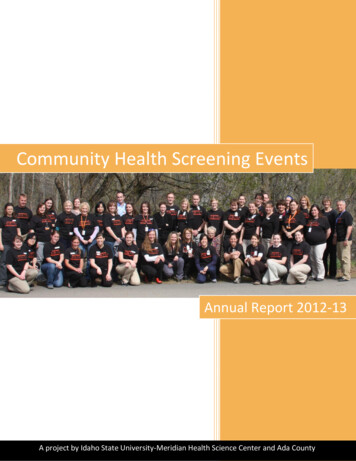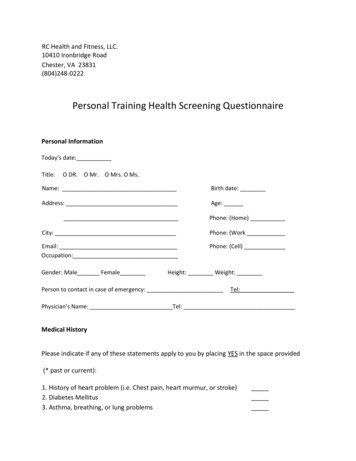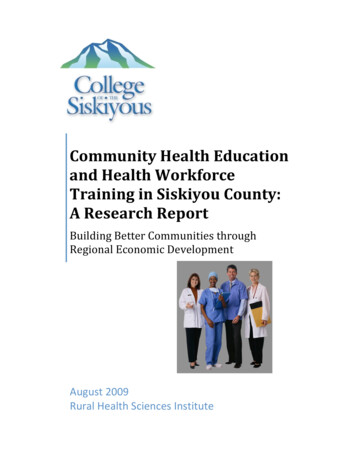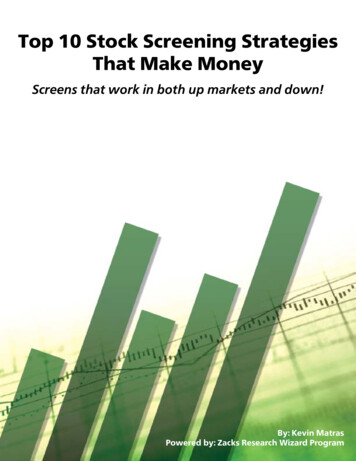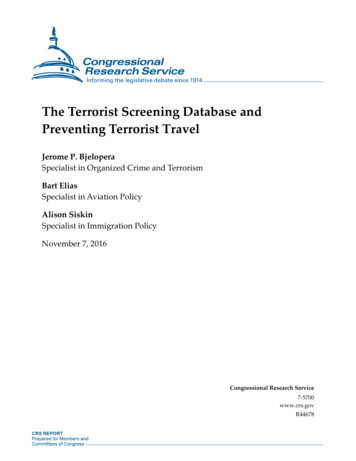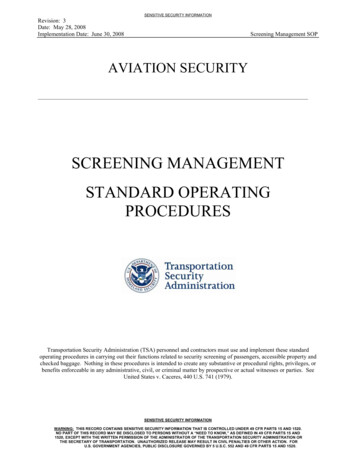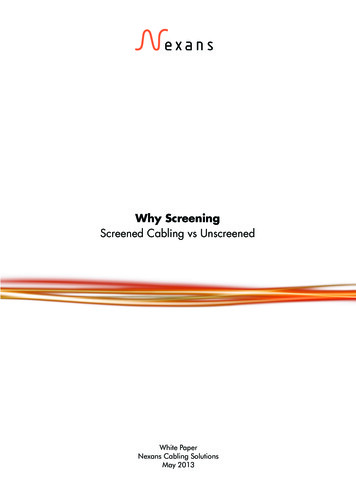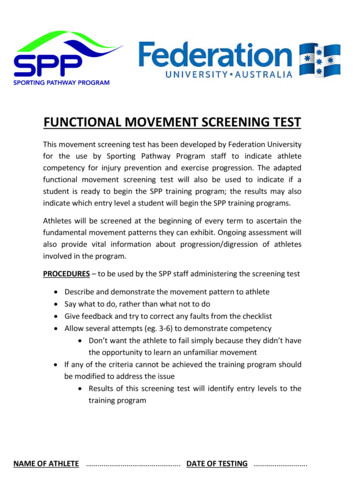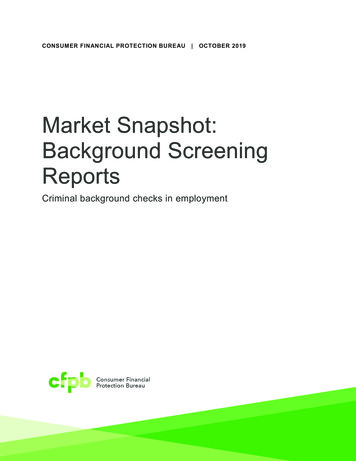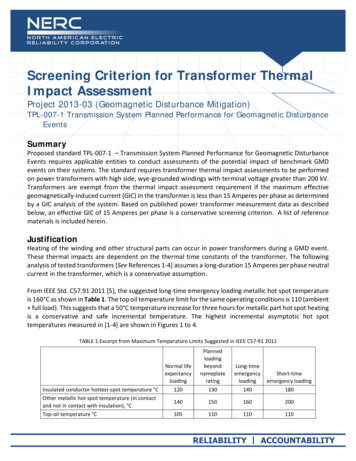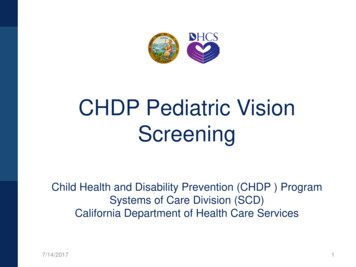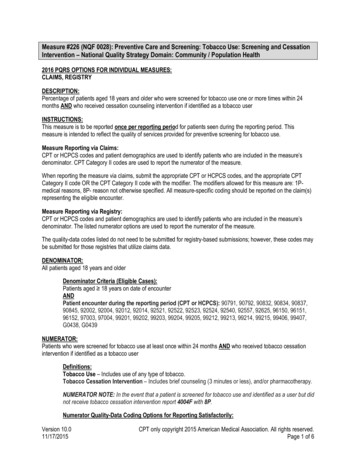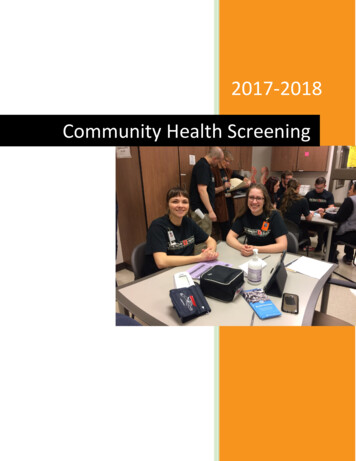
Transcription
2017-2018Community Health Screening
Table of ContentsLETTER FROM THE DIRECTOR .2IDAHO STATE UNIVERSITY- MERIDIAN HEALTH SCIENCE CENTER .3COMMUNITY HEALTH SCREENING HISTORY: PAST TO PRESENT .4CORE MISSIONS .4THE SCREENING PROCESS .5BY THE NUMBERS .6SPECIAL REPORTS .8CORE PLANNING TEAM .9KEY COMMUNITY SUPPORTERS.10FUTURE COMMUNITY HEALTH SCREENING EVENTS.10CONTACT US .11COMMUNITY HEALTH SCREENING ANNUAL REPORT 2017-20181
Letter from the DirectorDear Friends, Supporters and Colleagues;Another academic year came to an end and the joy of graduation filled me with wonderand awe. I wondered where the time went and what our graduates will do with theirchosen profession. I am in awe with the thought that over 1100 individuals havereceived preventative services from our faculty, students and residents through IdahoState University- Meridian Health Science Center’s Community Health Screening (CHS)project since January 2010.While the CHS screening process has changed significantly since the early years, thefundamental missions of the project has not: utilize interprofessional teams of students,identify potential medical, dental and/or mental health concerns and connect those inneed to a primary medical home. This is a tough mission to fulfill. Our community islucky to have so many wonderful individuals and organizations devoted to providingaffordable care, necessary resources and collaboration with our project. Thesecollaborations allow us to have capacity to connect CHS participants with a medical,dental and/or mental health care home; however, cost of services and time constraintscontinue to be significant challenges for individuals presenting to one of our 6 eventsheld each year. This fact does not dampen our desire to accomplish our mission.Each event requires two Career Path Interns, approximately 30resident and student volunteers along with their clinical facultysupervisors. Over the course of the semester, our studentslearn from and interact with each other, while providingscreening services to participants with compassion andprofessionalism. The collaboration that occurs amongst thesestudents extends beyond a screening event and is visiblethroughout the halls of ISU.As we look forward to another year, we want to thank you foryour support and vision. Your continued partnership trulyenables us to reach our mission. Without your support, we would not be able to attractindividuals to our events, we would not be able to connect individuals to the care theyneed, and we would not have the financial capacity to provide the supplies needed tocarry out our Community Health Screening events. Thank you again!Sincerely,Glenda Carr, CHS DirectorCOMMUNITY HEALTH SCREENING ANNUAL REPORT 2017-20182
Idaho State University- Meridian Health Science CenterIdaho State University Meridian HealthScience Center offers over 30undergraduate and graduate programsincluding online degrees and servesapproximately 1,000 students and workingprofessionals in the Treasure Valley. ISUMeridian was selected as one of thenation’s top 10 branch campusesby Thebestcolleges.org. It is home of theL.S. Skaggs Pharmacy Complex and the L.S.& Aline W. Skaggs Treasure ValleyAnatomy and Physiology Laboratories.ISU-Meridian serves the Treasure Valleycommunity by offering affordable clinic services through the Delta Dental of IdahoDental Residency Clinic, Speech/Language Clinic, Counseling Clinic, and MedicationTherapy Management Clinic.ISU-Meridian has unique partnerships with private and public entities throughout theTreasure Valley for increased educational opportunities, research, and communityservice. Partners include West Ada School District, The College of Idaho, THE CORE:Idaho Coalition for Innovation in Health Research & MedTech.The following departments are involved with the Community Health Screening program.Accelerated NursingCommunication ScienceCounselingDental ResidencyDietetic InternshipHIV/Viral Hepatitis Education ProgramInstitute of Rural HealthMedical Laboratory SciencesPharmacyPhysician Assistant StudiesFor a complete list and descriptions of academic programs offered at ISU-Meridian HSCplease visit the following website: http://www.isu.edu/meridian/proms.shtmlCOMMUNITY HEALTH SCREENING ANNUAL REPORT 2017-20183
Community Health Screening History: Past to PresentSince January 2010, whenAda County approachedIdaho State UniversityMeridian Health ScienceCenter (ISU-Meridian HSC)to help find a way toreduce taxpayers’ burdenthrough better access toexisting medical services,the Community HealthScreening (CHS) programhas been providing betteraccess to medical care forthose in need.The CHS events have matured into a sustainable project that brings together medicalscreening services, health care education, government agencies and community partners.It is in our best interest as a community to identify people with the greatest medical needsand connect them to partners in the community who provide affordable care. The CHS ismeeting its goal utilizing efficient interprofessional teams and expanding partnerships forcare with a focus on incorporating many of the goals set forth in Healthy People 2020(USPSTF).Core MissionsThe CHS project has two core missions:1. Identify members of the community withpotential medical, mental and/or dentalhealth concerns and directly link them tocare.2. Create an interprofessional educationand practice opportunity for students;screenings allow students to provideservices within their scope of practice in ateam-based format.COMMUNITY HEALTH SCREENING ANNUAL REPORT 2017-20184
The Screening ProcessThe CHS team designed an interprofessional progressive screening process for participants; moststations build upon each other. Students of various health care disciplines collaborate to complete thescreening tasks. The screening process continually adapts to meet both participants’ needs and theeducational needs of the students. From a faculty perspective, the goal of the events is to have studentsfrom different disciplines work together as much as possible while ensuring that the students were stillfunctioning within their scope of practice. This interprofessional team approach is beneficial as itincreased communication between disciplines and built trusting relationships; students with one skill setwere able to rely on colleagues with a different background to assist them.StationCheck-InDentalLabsPhysical ExamHearingViral ResultsDuties/Tasks-Initiate paperwork including a liability release anddemographics form-Complete forms reviewed later in the process including:hepatitis C risk, nutrition screening, depression screening, drugand alcohol screening-Evaluate teeth and gum health-Check for signs of oral cancer-Conduct HIV screen-Review hepatitis C risk factor assessment-Collect and process:-Glucose and total cholesterol screen-Hepatitis C screen-Provide glucose and cholesterol results-Read HIV and hepatitis C results-Check blood pressure, height, weight, BMI-Conduct:-PHQ-9 and AUDIT to screen for depression and/or alcoholdependency-Medication review of drug allergies, prescription medicationstaken, and over the counter products used on a regular basis-Nutrition assessment identifying food insecurities-Vision screening-Traumatic brain injury screening utilizing theOhio State University-TBI IdentificationScreening Method-Examine ear health and wax build-up-Conduct audiology/hearing screening-Give HIV and hepatitis C test results-Provide risk reduction educationReferrals-Review screening document with participant-Give referrals when necessary and/or actual appointment timeswhen availableCheck Out-Collect informationDisciplines Involved-Career Path Interns-Dental-Pharmacy-Medical Lab Sciences-Accelerated Nursing-Pharmacy-Physician Assistant-Accelerated Nursing-Dietetic Intern-Pharmacy-Physician Assistant-Audiology/CSD/SLP-Frontier AETC-Accelerated Nursing-Dietetic Intern-Pharmacy-Physician Assistant-Pharmacy-Career Path InternsCOMMUNITY HEALTH SCREENING ANNUAL REPORT 2017-20185
By The NumbersIn the 2017-2018 academic year, the Community Health Screening saw 116 participants.Of these participants, 62.9% identified as female and 35.3% identified as male; theaverage age of participants was 47.4 years old.The CHS is attracting a more diverse population compared to the overall ethnicity ofIdaho. According to the CDC’s 2016 Behavioral Risk Factor Surveillance System (BRFSS)Idaho’s ethnicity data, breaks down as follows: 84.8% White-non-Hispanic, 10.2%Hispanic, 1.2% American Indian/Alaskan Native, 1.2% Asian and 1.6% Multiracial. 1Reported ethnicity among CHS participants: 48.3% Caucasian, 20.7% Hispanic, 13.8%Asian and 17% other.Our mission is to connect those with limited access to care. This year, 55.2% of CHSparticipants indicated that they currently lack medical insurance, compared to 15.5% ofIdahoans reporting not having insurance.1 The average length of time without insurancefor participants was found to be 3.1 years. Of the CHS participants, 50.8% reported nothaving a primary care provider versus 27.7% of Idahoans report not having a primarycare provider.1According to BRFSS data in 2016, 27.4% of Idahoans were classified as obese (BMI 30).1 During this past school year, the CHS saw 37.1% of participants who wereclassified as obese. Only 12, or 10.3%, of participants reported some sort of tobacco use;this is much lower than the reported 38% for the state of Idaho in 2016.1In 2015, 31.3% of Idaho adults had been told that they had high blood pressure.1 In the2017-2018 academic year, the CHS identified that 47.4% of participants had high bloodpressure. Hypertension guidelines recently changed, which may account for moreindividuals classified as having high blood pressure. 2The Personal HealthQuestionnaire (PHQ-9) wasadministered to participants toassess for symptoms ofdepression. 3 Those presentingwith a score of five or morereceived a counseling referral.While most participants fellbelow the score for furtherscreening, 42% of participantPHQ-9 Depression ScoresNone (0-4)Mild (5-9)Moderate (10-14)Moderately Severe (15-19)Severe (20-27)010203040506070Number of Participants1 Centers for Disease Control and Prevention, National Center for Chronic Disease Prevention and Health Promotion, Division of Population Health. BRFSSPrevalence & Trends Data [online]. 2015. [accessed Jul 13, 2018]. URL: https://www.cdc.gov/brfss/brfssprevalence/.2 Whelton PK, Carey RM, Aronow WS, Casey DE, Colling KJ, et al. 2017 ACC/AHA/AAPA/ABC/ACPM/AGS/APhA/ASH/ASPC/NMA/PCNA Guideline for the Prevention,Detection, Evaluation, and Management of High Blood Pressure in Adults. Journal of the American College of Cardiology Nov 2017.3 Kroenke K, Spitzer RL, Williams JBW. The PHQ-9: Validity of a Brief Depression Severity Measure. Journal of General Internal Medicine. 6009606.x.COMMUNITY HEALTH SCREENING ANNUAL REPORT 2017-20186
scores prompted need for further investigation of depression. Twenty-one participantsexpressed interest in counseling regardless of their PHQ-9 score.Through collaboration with the Idaho Food Bank, participants may receive a food boxbased on the number of individuals living within their household. Two questionsascertain potential food insecurities of each participant. Students in need take home anyremaining food items at the end of the screening event."Were you worried that foodwould run out before you wereable to get money for more?"62%Yes"Did you run out of foodbefore you got money to buymore?"27%38%73%NoYesNoThe Community Health2017-2018 Referrals MadeScreening identified 16470concerns leading toreferrals for 11660participants presenting this50year. Most individualsreceived more than one40type of referral. The CHS30scheduled 1020appointments forparticipants; 6 ISU Wax10Removal appointments0and 1 appointment at eachAudiology CounselingDentalHearingMedicalWaxof the following clinics:RemovalGenesis Health, FamilyUrgentGeneralMedicine Residency ofIdaho, ISU Dental Clinicand Terry Reilly. Participants presented to all 10 scheduled appointment times. Therewere more appointment times provided by our community partners; however, cost andtime were the most common reasons for not scheduling follow-up at the time of theevent.COMMUNITY HEALTH SCREENING ANNUAL REPORT 2017-20187
Special ReportsTraumatic Brain Injury Screening by Russ Spearman, M.Ed.The TBI project team joined the CHS program in 2014 to identify individuals withpotential TBI and connect them to a primary care medical home and other specialty services.Idaho is the only state to use two screening tools for Traumatic Brain Injury (TBI); theOhio State University TBI identification Method followed by a Quality of Life After Brain Injuryquestionnaire within two weeks. The Quality of Life Interview can trigger a referral for speech,counseling, or other services when needed.During the 2017-2018 academic year screening for TBI was provided to 199 individuals,across 8 events with 41% screening “likely” for TBI. Individuals who screen likely are eligible fora primary care referral. Of the 21 individuals who consented to follow-up, 38% also completedthe Quality of Life After Brain Injury questionnaire. Screenings primarily took place in Ada andCanyon counties with two screenings taking place in Pocatello.ISU has agreements with Unity Health and Health West to accept TBI referrals for primarycare. Additionally, a grant was obtained from the Blue Cross of Idaho foundation to assist withco-pays for individuals without health insurance who screen “likely”. Future efforts will includeexpanding the network of referrals for care and securing additional supplemental funding tosupport services for individuals who fall into the gap of insurance coverage.Improving Mental Health Literacy in the Community by Jennifer Forbes, MHS, PA-C; Jared Papa,MPAS, PA-C; Glenda Carr, PharmD; Talia Sierra, MPAS, PA-CA PA faculty member received agrant from the PA Foundationthrough its mental health-focusedIMPACT grant program todevelop a mental healthcurriculum to address healthdisparities through the CHS. Thecurriculum was designed toenhance depression screening byincorporating mental healtheducation into the process. Theinteractive mental health educational session was student-delivered through the use of iPads anda PowerPoint presentation. The curriculum included instruction on why mental health isimportant, contributing factors to mental health, recognizing signs of a mental health disorderand mental health crisis, what to do in a mental health crisis, and provides a list of local andnational resources for mental health evaluation and treatment. Educational pamphlets wereprovided to each participant summarizing the main points from the educational session. Resultsfrom surveys regarding knowledge and attitudes about mental health showed an improvement inthe community participants and students delivering the curriculum.COMMUNITY HEALTH SCREENING ANNUAL REPORT 2017-20188
Core Planning TeamGlenda Carr, PharmDCHS Director; ClinicalAssistant Professor ofPharmacy PracticeGabriel Bargen, PhDAssistant ProfessorCommunication Sciences &Disorders and Education ofthe DeafKris Hilvers, MS RDN LD CNSCDietetic Internship DirectorLiz Horn, PhD,Assistant Professor CounselingRebekkah Hulen, RNAssistant Clinical Nursing ProfessorMarjori Montanus, MHPE, MLS(ASCP)SBBAssistant Professor Medical LaboratoryScienceJared Papa, MPAS, PA-CClinical Associate Professor PhysicianAssistant StudiesPam Powell, DMDCo-Site DirectorISU Family DentistryAssociate Professor of Dietetics; DieteticsInternship DirectorRuth Schneider, MPH, RD, LDRuss Spearman, M.Ed.Institute of Rural HealthLily Killian, MS MLS(ASCP) cmAdjunct Professor Medical LaboratorySciencesJudy Thorne, MPA, RTProgram Coordinator HIV/ViralHepatitis EducationRachel Smith, PharmD Candidate 2019Lead Career Path InternChelsea Bagby, PharmD Candidate 2020Career Path InternCOMMUNITY HEALTH SCREENING ANNUAL REPORT 2017-20189
Key Community SupportersIdaho Food BankTerry Reilly- MedicalFamily Medicine Residencyof IdahoAda County IndigentServicesFriendship ClinicIdaho State UniversityClinicsUnity Health CenterHispanic Cultural Center of IdahoWhitney United Methodist ChurchWhittier ElementaryInstitute of Translational Health ScienceFuture Community Health Screening EventsParticipants may arrive any time between 4:00pm and 7:00pm. Once the screeningbegins, it may take 90 minutes to complete the entire process. Flu shots will be availablewhile supplies last.Fall SemesterSeptember 20th, 2018Whittier ElementaryOctober 18th, 2018Garfield ElementaryNovember 15th, 2018First Baptist ChurchSpring SemesterFebruary 14th, 2019*March 14th, 2019*April 11th, 2019**Location not yet finalized at the time of distribution.COMMUNITY HEALTH SCREENING ANNUAL REPORT 2017-201810
Contact UsPlease contact us at: healthyU@isu.eduTo contact the project director:Glenda Carr, PharmDClinical Assistant ProfessorPharmacy Practice and Administrative SciencesIdaho State University College of PharmacyPh: 208-373-1840Email: carrglen@isu.eduCOMMUNITY HEALTH SCREENING ANNUAL REPORT 2017-201811
Accelerated Nursing Communication Science Counseling Dental Residency Dietetic Internship HIV/Viral Hepatitis Education Program Institute of Rural Health Medical Laboratory Sciences Pharmacy Physician Assistant Studies . For a complete list and descriptions of academic programs offered at ISU -Meridian HSC please visit the following website:
